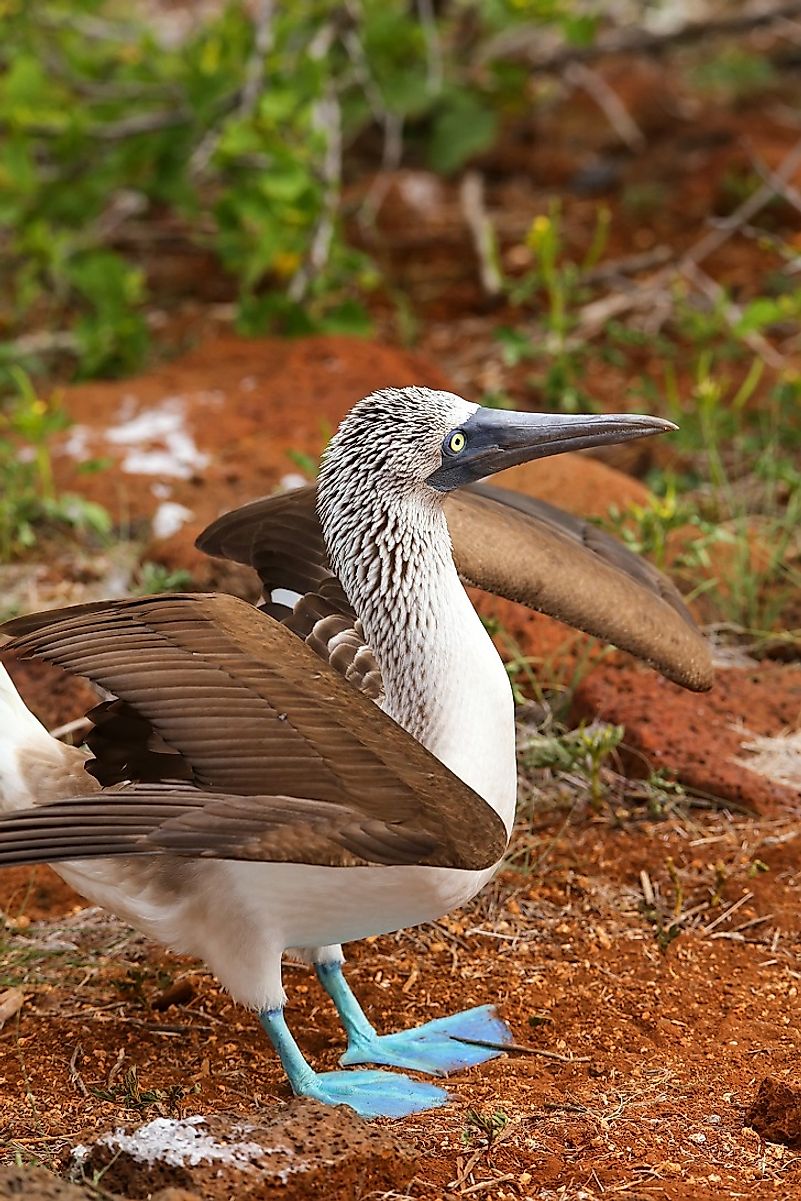Blue-Footed Booby Facts: Animals of North America

5. Physical Description
The Blue-Footed Booby is a seabird whose bizarre bright, blue, webbed, feet are highly conspicuous. The Blue-Footed Booby has a sturdy, grayish-blue beak, and the feathers on their wings are brown, with those on their smooth underbellies being white. The Blue-Footed Booby's back has light brown feathers extending to its head, and those on the tail are dark brown, with their eyes being yellow. According to ARKive Initiative, in adulthood the Blue-Footed Booby's length ranges from 76 to 84 centimeters, with a wingspan of 152 to 158 centimeters. A male Blue-Footed Booby weighs from 1.1 to 1.5 kilograms, while females are generally somewhat larger, weighing 1.3 to 2 kilograms when mature.
4. Diet
As a carnivorous bird, fish is the main staple in the diet of the Blue-Footed Booby, according to a study by the Cornell Lab of Ornithology. The Blue-Footed Booby consumes sixteen fish species, including the Peruvian anchovy and sardines, and also eats one species of squid. The Blue-Footed Booby forages for its prey during the day, and can travel as far as 30 kilometers offshore. To catch its prey, it can dive to depths of more 20 meters under the water surface, and remain submerged for over 30 seconds. Still, most Blue-Footed Booby dives are shallow, around 4 meters in depth and lasting roughly 6 seconds. Studies report that females typically dive deeper and stay submerged longer than do males. Researchers attribute that either to females avoiding competition with males for foraging microhabitat, or to gravitational acceleration, as they are heavier.
3. Habitat and Range
The Ecuadorian Galapagos Islands hosts half of all breeding pairs of the Blue-Footed Booby. Nonetheless, there are still considerable populations along the Pacific Coast of the Americas, specifically in northern and southern Peru, northern Chile, northern California in the U.S., and Mexico. Those coasts provide ideal environment to nest on open ground, rocky coasts, cliffs or islands, and to forage in offshore waters. The International Union for Conservation of Nature's 2015 Red List report classifies the Blue-Footed Booby as a species of "least concern" among threatened species. But a 2014 study on Galapagos Island, conducted by Avian Conservation and Ecology, reported its population had dropped to 6,400 birds, as compared to 20,000 in the 1960s. Researchers attributed the drop to diminished breeding activity and sardine shortages, as consuming these fish boosts reproduction among the Blue-Footed Booby.
2. Behavior
The Blue-Footed Booby is an excellent diver, and at times catches fish flying out of the water, but clumsy on land. When it desires to dive to the maximum depth into the water and immediately return to surface, it utilizes the V-shaped dive. There is also the U-shaped dive characterized by zigzagging displacement, and occurs when the Blue-Footed Booby dives to maximum depth. It flying speed is 39 kilometers an hour and its foraging trips last up to 13 hours. The Blue-Footed Booby is social, and a cluster can have as many as 200 birds, though they become more territorial when breeding.
1. Reproduction
Sexual maturity for the Blue-Footed Booby begins at around 2 to 3 years. According to Marine Bio, breeding may occur at any time of the year. To mate with a female, the male shows off its blue feet in a boastful strut, and presents nesting materials to the female. The male repeats the boastful strut again, and afterwards both tilt their beaks upwards, and produce piercing whistles and groans, and then they finally mate. A female lays 2 to 3 eggs on flat shallow depression, on flat ground. The female incubates the eggs with its webbed feet. When the eggs hatch the mother supports the young birds on its webbed feet for a month, and feeds them on regurgitated fish. The average lifespan of a Blue-Footed Booby is 18 years in the wild.







